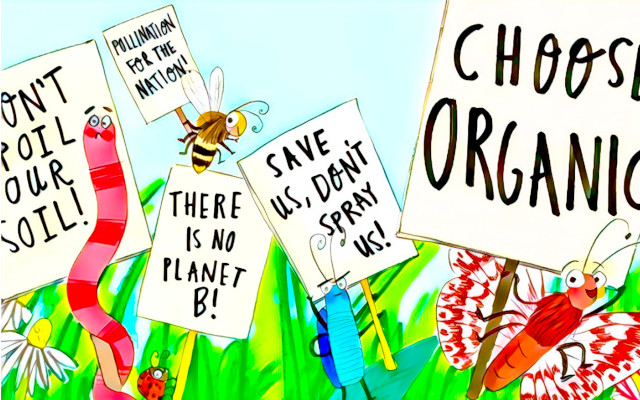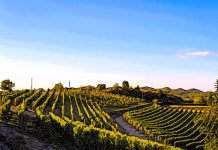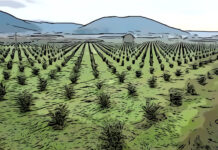The organic system offers the best guarantees of sustainable development–based on uniform rules in the Old Continent since 1991 (1)–and accidental contamination by pesticide residues in organic products, while possible, is subject to special rules.
A recent scientific review (Schleiffer et al., 2022) offers useful insights into distinguishing technically unavoidable cases of contamination from fraud, which the strengthened organic control regime tends to minimize in any case (2,3).
The real problem, which only the conversion of agriculture to the organic method can mitigate, is the environmental contamination by agrotoxics and microplastics caused by the ‘conventional’ farming method. Insight.
1) Biological system and sustainable development. Foreword
The overall objectives of the organic production system are the best expression of the sustainable development goals, in the agriculture and food supply chains, as declined in the Sustainable Development Goals (SDGs) and EU sector strategies. Primarily:
(a) Contribute to environmental and climate protection (#SDG13, #SDG14, #SDG15.
EU Green Deal
),
(b) to conserve soil fertility in the long term (#SDG15, Life on land. Soil strategy 2030, Integrated action plan for nutrient management in agriculture. See notes 4,5)
(c) contribute to a high level of biodiversity(Biodiversity 2030), (6)
(d) effectively contribute to a non-toxic environment, (7)
(e) contribute to strict animal welfare criteria and meet, in particular, the specific behavioral needs of animals according to species,
(f) promote short supply chains and local production in the various areas of the Union, (8)
(g) Encourage the maintenance of rare and native breeds that are endangered (9,10,11).
2) Accidental contamination of organic products, EU rules
Reg. EU 2018/848 establishes a set of measures to prevent the presence of unauthorized products and substances (Art. 28), defines obligations and actions in case of suspected non-compliance (Art. 27), and measures to be taken in case of residues of unauthorized products or substances (Art. 29).
‘The mere presence of residues of an unauthorized substance in a product intended to be used or marketed as organic is grounds for suspicion of noncompliance,’ explains Roberto Pinton, a member of the Regulatory Task Force of IFOAM Organics Europe. (12)
2.1) Self-monitoring, suspected residues and official controls.
‘Operators-in addition to being subject to third-party and competent authority inspections-are required to maintain a system of self-inspection. If this system reveals the presence of residues of an impermissible substance, the operator is required to identify and segregate the product, without placing it on the market, and to check whether the suspicion is well-founded.
If the suspicion is confirmed or the related risk cannot be ruled out, the operator must inform the inspection body, which must immediately conduct an official investigation in accordance with EU Regulation 2017/625 to determine the sources and cause and to verify whether or not the product complies‘ (Roberto Pinton, IFOAM).
2.2) Focus on process and procedures
The measures defined in reg. EU 2018/848 in the case of residues of impermissible substances express an approach that is rooted in the process and procedures to be followed, rather than introducing tolerance thresholds. Indeed, it is essential to always demand timely compliance by operators, even in cases where technically unavoidable contamination beyond their control may occur. In line with precedents pertaining to more strictly protected products:
– baby food
. Directive 2006/125/EC on foods for infants and young children under the age of 3, in affirming the ban on the use of pesticides, recognizes that this, ‘however, does not necessarily guarantee that the products do not contain the pesticides, as some of them contaminate the environment, so their residues can be found in the products‘,
– infant food
. Directive 2006/141/EC, on infant formula and follow-on formula, in turn notes how the ban on the use of pesticides in agricultural products intended for them ‘does not necessarily guarantee that products are free of such pesticides, as some pesticides contaminate the environment and their residues may still be present in the affected products‘. Some substances in fact ‘have a slow rate of degradation and continue to contaminate the environment.’
2.3) Post-harvest precautions.
Cross-contamination can also occur in the post-harvest stages, and it is therefore that reg. EU 2018/848 establishes a spatio-temporal separation of the processing of organic and conventional products. As well as mandating proper cleaning and disinfection in processing and storage facilities. Cross-contamination can indeed occur due to:
- fumigants (used to disinfect truck boxes, trailers and containers) capable of crossing plastic barriers and thus reaching food,
- tools and storage and processing facilities not properly cleaned between (non-organic) and (organic) processing.
3) Technically unavoidable residuals
EU Regulation 2018/848-not being able to prescribe ‘impossible’ requirements-therefore requires operators to achieve the best possible performance:
- the European Commission, by 31.12.25, may submit a legislative proposal to harmonize by procedures to be followed,
- some member states, meanwhile, have established thresholds and procedures to be applied at the national level. Some examples follow.
4) Accidental contamination of organic products, national standards
In Belgium, organic products with residues exceeding one and a half times the LOD(limit of detection) must be de-certified by control bodies. Unless the operator can prove that the presence of the unauthorized substance resulted from factors outside his responsibility.
In Germany, organic product on which no more than two substances above 0.01 mg/kg are detected is considered compliant, unless if there is no evidence of rule violation. Thus, the investigation concludes with an assessment of product conformity following a finding that the contamination was accidental in nature and that the operator took all reasonable precautionary measures.
Italy has introduced the strictest rules, with Ministry of Agriculture, Food and Forestry Decree No. 309/2011(Accidental and technically unavoidable contamination of plant protection products in organic farming). Details follow.
5) Accidental contamination of organic food. The rules in Italy
DM 309/2011 applies the same threshold introduced at the EU level for technically unavoidable contamination of baby food to Italian organic products, which is 0.01 mg/kg (i.e., 1 g of impermissible substance per 100 tons of food):
- mere positivity in the analysis, even below the threshold of 0.01 mg/kg, requires an investigation by the inspection body to ascertain the cause,
- exceeding the 0.01 mg/kg limit excludes the possibility of certifying the product as organic, when even the investigation establishes the absolute regularity of the operator’s conduct and the inevitability of the contamination.
5.1) Phosphonic acid
The Italian Ministry of Agriculture, Food and Forestry (MiPAAF) then introduced some exemptions for phosphonic acid only, in the following cases and terms:
- DM 7264/2020 raised the numerical threshold for certification to 0.05 mg/kg, until Dec. 31.22. Noted special study by CREA (Council for Agricultural Research and Analysis of Agricultural Economics) where the high persistence of phosphonic acid in the woody parts of plants is demonstrated as a result of treatments allowed at a time before conversion to organic methods,
- law 11.9.20 no. 120, again on the instructions of MiPAAF, then allowed organic certification even in the case of higher levels of phosphonic acid, when the inspection body ascertains that its presence is due to the nature of the soil. As has already been established in fruits obtained on soils of volcanic origin.
6) Pesticide residues in organic products, the causes
The scientific review under review (Schleiffer et al., 2022), funded by IFOAM Organics Europe, offers some useful data to understand the phenomenon of accidental contamination of organic products:
- EFSA(European Food Safety Authority) found that about 6 percent of declared organic products placed on the EU market contained traces of synthetic pesticides,
- EOCC(European Organic Certifiers Council) in turn found that 43 percent of the above cases were certainly due to environmental contamination. (2)
6.1) The state of nature in the EU.
Organic farming – sole salvation of ecosystems from the pollution of soils, water and air by toxic chemicals and microplastics (13) caused by ‘conventional’ agriculture-still covers only 14,869,779 hectares in the EU, or 9.2 percent of the utilized agricultural area (17.4 percent in Italy, above average with 75,847 certified organic farmers).
The 349,499 organic farmers operating in the EU (2020 data, growing), accordingly:
- are literally surrounded by the more than 90 percent of land where synthetic pesticides are used. While waiting for member states to support conversion to organic, as agreed in the EU, (14)
- may introduce measures to contain the risks of cross-contamination in handling, transport and storage,
- cannot do much to inhibit the so-called ‘drift effect’ of pesticides (on soil, water and air), which is instead the task of institutions.
7) Pesticides, uses and consumption in the EU.
More than 333 thousand tons of pesticides are marketed and more than 450 substances are approved annually in the EU, for uses in agriculture and animal husbandry, private and public gardens, road and railway maintenance. These substances contaminate surface water and soils, eventually reaching groundwater. As well as being airborne, even over long distances as seen. (15)
7.1) Pesticides in soils.
About 50 percent of the substances are applied directly to soils to combat weeds, pests and/or pathogens. The other half of the substances, sprayed on plants, reach the soil through irrigation, rainfall and gravity.
The degradation times of substances are sometimes atavistic, as evidenced by the fact that substances banned for decades such as DDT and atrazine are still found in soils.
Pesticides and herbicides are then absorbed by the roots and spread into the plant through the vascular system.
7.2) Pesticides in water
‘THE ISPRA. (Superior Institute for Environmental Protection and Research) – a public research organization of the Ministry of Ecological Transition that periodically publishes the National Pesticides in Water Report – in 2017-2018 found pesticides in 77.3% of surface water monitoring points and 32.2% of groundwater monitoring points‘, recalls Roberto Pinton. (16)
‘But it’s not enough: In 21% of surface water monitoring points, the concentration is above the environmental limits set by law, as well as in 5.2% of deep groundwater. The substances most frequently exceeding limits in surface water are the herbicides glyphosate and metolachlor and the fungicides dimethomorph and azoxystrobin‘.
7.3) Groundwater, cocktail effect.
‘In the deep waters, along with the ubiquitous glyphosate we find the other herbicide bentazone and the fungicides triadimenol, oxadixyl and metalaxyl. (17) As ISPRA warns, humans and other organisms are thus exposed to a veritable cocktail of chemicals whose recipe is unknown‘, Roberto Pinton continued.
The impact on human health of multiple exposure to mixtures of agrotoxics, so-called cocktail effect, is itself almost unknown. Pending more advanced analyses (e.g., blood metabolomics, liver transcriptomics, and genome-wide DNA methylation analysis), which are, moreover, already available (18,19).
7.4) Pesticides in the air.
Agrotoxics are available in liquid, solid or gaseous forms. Gaseous particles enter the plant through stomata or cuticles, solid particles settle on plant surfaces and are thus absorbed. Other particles are deposited on plants and soils by rainwater and irrigation water.
Spraying is the primary cause of airborne pesticides, if even substances already applied to plants can be carried by the wind. A large-scale environmental study in the European macro-region (Jaward et al., 2004) found the highest levels of ppDDT in the air in Italy, Russia and Eastern Europe. (20)
8) Interim Conclusions.
The vibrant biodiversity found in organically cultivated fields compared with conventional cultivation (+68-105% plant species, +74-153% wild plants. Fuller et al., 2005) is indicative of the impact on life of pollutant particles contained in pesticides, herbicides, fungicides and other agrotoxics. (21)
‘It makes no sense to think of confining organic production to areas that are already pristine and in perfect ecological balance,’ concludes Roberto Pinton. ‘Instead, it is urgent to introduce those same production practices in the very areas where more intensive conventional cultivation has made and is making disasters.
If there are pesticide residues in 80 percent of the groundwater sampling points in the Po Valley, that is precisely where action needs to be taken, and it can only be done by starting to cut back on treatments and reintroducing good agronomic practices, rotations, organic fertilization, and care of the soil stock. But also with the correct information to the consumer’.
Dario Dongo and Alessandra Mei
Notes
(1) European Court of Auditors. Organic Food in the EU – Background Paper. February 2018. https://www.eca.europa.eu/Lists/ECADocuments/BP_ORGANIC_FOOD/BP_ORGANIC_FOOD_EN.pdf
(2) Schleiffer M, Speiser B. (2022). Presence of pesticides in the environment, transition into organic food, and implications for quality assurance along the European organic food chain – A review. Environ Pollut. 2022 Nov 15;313:120116. doi: 10.1016/j.envpol.2022.120116
(3) Donato Ferrucci, Dario Dongo. Organic controls in Italy, the ABCs and data. GIFT (Great Italian Food Trade). 7.3.19
(4) Dario Dongo. Soil protection, strategy 2030. THE ABC’S. GIFT (Great Italian Food Trade). 6.12.21
(5) Donato Ferrucci, Dario Dongo. Soil nutrition and crops, the integrated action plan in EU. GIFT (Great Italian Food Trade). 10.7.22
(6) Dario Dongo, Giulia Torre. Special – EU 2030 Strategy for Biodiversity, the plan announced in Brussels. GIFT (Great Italian Food Trade). 31.5.20
(7) Marta Strinati. Pesticides, two-thirds of the planet at risk of environmental pollution. GIFT (Great Italian Food Trade). 26.9.22
(8) Dario Dongo. Short supply chain, concepts and values. GIFT (Great Italian Food Trade). 27.9.19
(9) EU Reg 2018/848, Article 4
(10) Dario Dongo. Organic, EU reg 2018/848. GIFT (Great Italian Food Trade). 22.6.18
(11) Donato Ferrucci, Dario Dongo. Production and labeling of organic products, starting reg. EU 2018/848. THE ABC’S. GIFT (Great Italian Food Trade). 2.2.22
(12) IFOAM Organics Europe is the European umbrella organization for organic food and farming. Represents nearly 200 organizations in 34 European countries, consisting of farmers and processors, retailers and distribution operators, certification bodies, consultants, researchers, environmental and consumer organizations
(13) Marta Strinati. Microplastics in pesticides, the CIEL report. GIFT (Great Italian Food Trade). 20.7.22
(14) Marta Strinati. National strategic plans, organic budget to be revised. IFOAM requests. GIFT (Great Italian Food Trade). 8.6.22
(15) Dario Dongo. The drift effect of pesticides on bees, trees and plants away from cropland. GIFT (Great Italian Food Trade). 21.12.20
(16) Dario Dongo. ISPRA, 2020 report on pesticides in water. GIFT (Great Italian Food Trade). 24.12.20
(17) Dario Dongo, Martina Novelli. Metalaxyl, the most widely used fungicide in Italian agriculture. What risks? Égalité. 23.2.20
(18) Marta Strinati. Pesticide cocktails cause toxicity, even at doses allowed in the EU. New study. GIFT (Great Italian Food Trade). 24.10.20
(19) Alberto Mantovani. Toxic cocktails? Risk assessment of multiple exposures to endocrine disruptors. GIFT (Great Italian Food Trade). 28.9.20
(20) Foday M. Jaward, Nick J. Farrar, Tom Harner, Andrew J. Sweetman, Kevin C. Jones (2004). Passive Air Sampling of PCBs, PBDEs, and Organochlorine Pesticides Across Europe. Environ. Sci. Technol. 2004, 38, 1, 34-41. https://doi.org/10.1021/es034705n
(21) R.J. Fuller, L.R. Norton, R.E. Feber, P.J. Johnson, D.E. Chamberlain, A.C. Joys, F. Mathews, R.C. Stuart, M.C. Townsend, W.J. Manley, M.S. Wolfe, D.W. Macdonaid and L.G. Firbank (2005). Benefits of organic farming to biodiversity vary among taxa. Biol Lett. 2005 Dec 22;1(4):431-4. doi: 10.1098/rsbl.2005.0357









